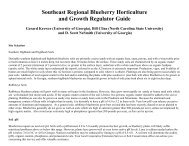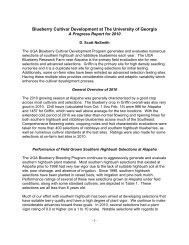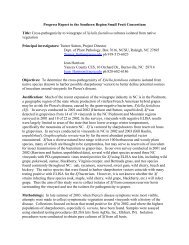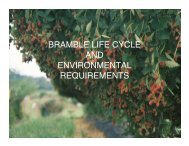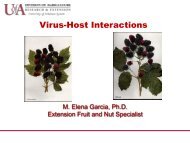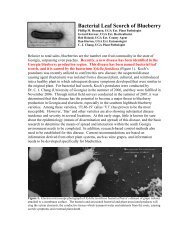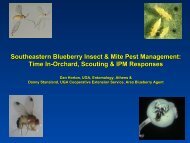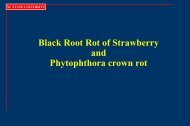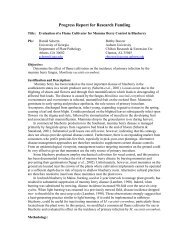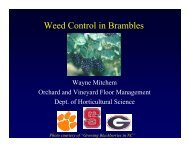Blueberry Cultivar Development at The University of Georgia
Blueberry Cultivar Development at The University of Georgia
Blueberry Cultivar Development at The University of Georgia
You also want an ePaper? Increase the reach of your titles
YUMPU automatically turns print PDFs into web optimized ePapers that Google loves.
Multi-loc<strong>at</strong>ion Yields and Performance <strong>of</strong> Advanced Rabbiteye SelectionsIn addition to the multi-year yield d<strong>at</strong>a from Alapaha, in 2003 we were able to collect yieldand performance d<strong>at</strong>a for three advanced selections <strong>at</strong> three diverse test sites (Table 4).Chill hours (calcul<strong>at</strong>ed from Oct. 1 thru Feb. 15) <strong>at</strong> the loc<strong>at</strong>ions in 2003 were as follows:Blairsville had 1800 to 1850; Griffin had 1340 to 1390; Alapaha had 900 to 950. Plants<strong>at</strong> Alapaha were m<strong>at</strong>ure plants (more than 10 years old); whereas, plants <strong>at</strong> Griffin andBlairsville were generally very young (only 2 years old), except for the Tifblue and T-459plants in Griffin, which were 4 years old. Bloom d<strong>at</strong>es in Griffin were generally 8 to 14 daysl<strong>at</strong>er for a particular selection than <strong>at</strong> Alapaha, and Blairsville bloom d<strong>at</strong>es were generally2 to 3 weeks l<strong>at</strong>er than in Griffin. Bloom d<strong>at</strong>e ranking was similar <strong>at</strong> the loc<strong>at</strong>ions, exceptfor T-451. T-451 is one <strong>of</strong> the earlier blooming selections in south <strong>Georgia</strong>, but it wasamong the l<strong>at</strong>er blooming ones in middle and north <strong>Georgia</strong>. T-584 generally bloomed aweek l<strong>at</strong>er than Climax <strong>at</strong> all loc<strong>at</strong>ions, but ripened with the standard cultivar. Thisresponse <strong>of</strong> T-584 indic<strong>at</strong>es it would be a better early season choice due to the fact th<strong>at</strong>it blooms l<strong>at</strong>er, thus missing some early season freeze events th<strong>at</strong> would harm Climax.<strong>The</strong> further north we went, the closer ripening d<strong>at</strong>es for Brightwell and Climax were. Asimilar trend was observed for Tifblue and T-459.T-584 performed well across the environments, yielding more than Climax <strong>at</strong> two <strong>of</strong> theloc<strong>at</strong>ions. This is additional evidence th<strong>at</strong> the selection would make a good cultivar. T-459tended to have similar yield to th<strong>at</strong> <strong>of</strong> Tifblue across loc<strong>at</strong>ions, but again, berry size is morefavorable for T-459. Berry size <strong>of</strong> T-451 was very large across all loc<strong>at</strong>ions, and berry size<strong>of</strong> T-459 was large to very large. Climax berries were very small in south <strong>Georgia</strong>, but sizebecame more favorable as we moved north. Berry size <strong>of</strong> all selections was generallygre<strong>at</strong>est in the cooler mountain loc<strong>at</strong>ion <strong>of</strong> Blairsville.<strong>The</strong> d<strong>at</strong>a from the multi-loc<strong>at</strong>ion tests are very valuable in determining the adaptability <strong>of</strong>selections across environments. We will continue to monitor these selections <strong>at</strong> theloc<strong>at</strong>ions for a few more years, and we will add new plantings <strong>of</strong> selections to the varioussites.Performance <strong>of</strong> Southern Highbush Selections <strong>at</strong> Alapaha<strong>The</strong> UGA <strong>Blueberry</strong> Breeding Program continues to aggressively gener<strong>at</strong>e and evalu<strong>at</strong>esouthern highbush plant m<strong>at</strong>erial. Most southern highbush selections th<strong>at</strong> existed <strong>at</strong>Alapaha prior to 1998 had very low vigor due to the lack <strong>of</strong> suitable highbush soil <strong>at</strong> thesite, poor drainage, and absence <strong>of</strong> irrig<strong>at</strong>ion. <strong>The</strong> exception was the selection TH-471,which has proved to have a nominal level <strong>of</strong> vigor. This selection was submitted forrelease in 2003, and additional d<strong>at</strong>a concerning this is presented l<strong>at</strong>er in the report.Since 1998, southern highbush selections have been planted in raised beds, with irrig<strong>at</strong>ionand pine bark mulch. Performance <strong>of</strong> several <strong>of</strong> these new selections <strong>at</strong> Alapaha, along-4-



